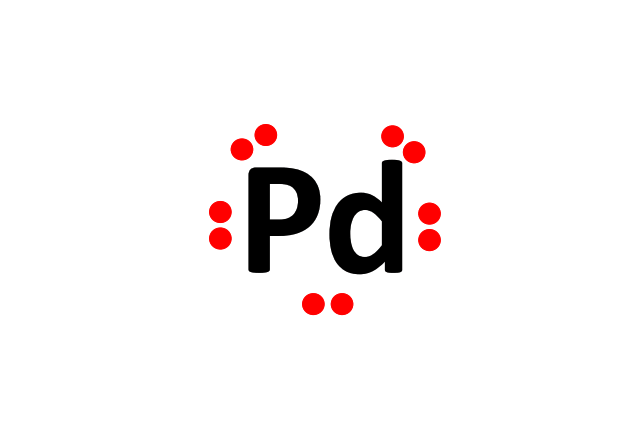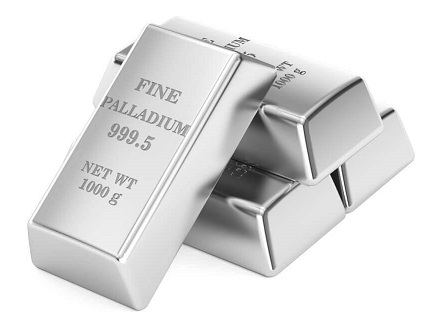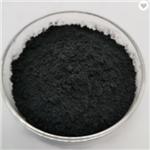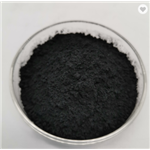Palladium
- CAS No.
- 7440-05-3
- Chemical Name:
- Palladium
- Synonyms
- LINDLAR CATALYST;Palladium on activated charcoal;PALLADIUM 10% ON CARBON;10%Pd;Paladium;Rosenmund catalyst;5% PALLADIUM ON CARBON;Palladium wire;Palladium on calcium;Pd/C Palladium/Carbon
- CBNumber:
- CB5854181
- Molecular Formula:
- Pd
Lewis structure

- Molecular Weight:
- 106.42
- MDL Number:
- MFCD00011167
- MOL File:
- 7440-05-3.mol
- MSDS File:
- SDS
| Melting point | 1554 °C(lit.) |
|---|---|
| Boiling point | 2970 °C(lit.) |
| Density | 1.025 g/mL at 25 °C |
| storage temp. | no restrictions. |
| solubility | soluble in aqua regia |
| form | wire |
| Specific Gravity | 12.03 |
| color | Silver-gray |
| Odor | Odorless |
| Resistivity | 9.96 μΩ-cm, 20°C |
| Water Solubility | INSOLUBLE |
| Merck | 14,6989 |
| Exposure limits |
ACGIH: TWA 1 mg/m3 OSHA: TWA 15 mg/m3; TWA 5 mg/m3 |
| Stability | Stable. Flammable - fine powder may cause fire or explosion in air. Incompatible with ozone, sodium tetrahydroborate, sulphur, arsenic. |
| InChIKey | KDLHZDBZIXYQEI-UHFFFAOYSA-N |
| CAS DataBase Reference | 7440-05-3(CAS DataBase Reference) |
| EWG's Food Scores | 4 |
| FDA UNII | S66WSD7L96 |
| NIST Chemistry Reference | Palladium(7440-05-3) |
| EPA Substance Registry System | Palladium (7440-05-3) |
| Modulus of Elasticity | 117 GPa |
|---|---|
| Poissons Ratio | 0.39 |
| Shear Modulus | 42.0 GPa, Calculated |
| Hardness, Vickers |
37, Annealed 105, Cold Drawn |
SAFETY
Risk and Safety Statements
| Symbol(GHS) |  GHS07 |
|||||||||
|---|---|---|---|---|---|---|---|---|---|---|
| Signal word | Warning | |||||||||
| Hazard statements | H315-H319 | |||||||||
| Precautionary statements | P305+P351+P338 | |||||||||
| Hazard Codes | T,F,Xi | |||||||||
| Risk Statements | 61-33-37/38-40-41-36/37/38-11 | |||||||||
| Safety Statements | 53-26-36/37/39-24/25-36-22 | |||||||||
| RIDADR | UN 3089 4.1/PG 2 | |||||||||
| WGK Germany | - | |||||||||
| RTECS | RT3480500 | |||||||||
| Autoignition Temperature | >1120 °F | |||||||||
| TSCA | Yes | |||||||||
| HazardClass | 4.1 | |||||||||
| PackingGroup | III | |||||||||
| HS Code | 28439000 | |||||||||
| Toxicity | LD50 oral (rat) 200 mg/kg (palladium chloride) LC50 intratracheal (rat) 6 mg/kg (palladium chloride) |
|||||||||
| NFPA 704 |
|
Palladium price More Price(828)
| Manufacturer | Product number | Product description | CAS number | Packaging | Price | Updated | Buy |
|---|---|---|---|---|---|---|---|
| Sigma-Aldrich | GF60084424 | Palladium foil, light tested, 100x100mm, thickness 0.025mm, as rolled, 99.99+% | 7440-05-3 | 1EA | $3000 | 2024-03-01 | Buy |
| Sigma-Aldrich | 908134 | Palladium on calcium carbonate Evonik Noblyst? P8059 5% Pd | 7440-05-3 | 10G | $230 | 2024-03-01 | Buy |
| Sigma-Aldrich | 908002 | Palladium on calcium carbonate Evonik Noblyst? P1152 5% Pd | 7440-05-3 | 10G | $230 | 2024-03-01 | Buy |
| Sigma-Aldrich | 75993 | Palladium on activated charcoal moistened with water, 10% Pd basis (based on dry substance) | 7440-05-3 | 10G | $175 | 2024-03-01 | Buy |
| Sigma-Aldrich | 75992 | Palladium on activated charcoal 5% Pd basis | 7440-05-3 | 1g | $47.1 | 2024-03-01 | Buy |
Palladium Chemical Properties,Uses,Production
Description
Palladium was discovered in 1803 by W.H. Wollaston during refining and purification of- platinum metal. This new metal was found in the aqua regia extract of native platinum and was detected in solution after platinum was precipitated. It was removed as ammonium chloroplatinate. Treating this solution with mercurous cyanide precipitated a yellow palladium complex salt. The precipitate was washed and ignited to form palladium metal. Wollaston named the element palladium after the newly discovered asteroid Pallas.
Palladium in nature is always associated with other platinum group metals. Its abundance in earth's crust is estimated at 0.015 mg/kg, about three times more abundant than platinum. Palladium is used mostly in alloys and the majority of its alloys are used for electronics and telecommunications. They are contacts in electrical relays and automatic switching gear. Palladium-gold alloys are applied widely in dentistry and medicine. They are in devices for replacement of damaged bones and joints and as support in porcelain-overlay bridgework. Palladium alloys are used in decoration and jewelry as a substitute for gold. They are used in gems, watch cases and brooches.
One of the most important applications of palladium is to catalyze hydrogenation, dehydrogenation, and petroleum cracking. Such reactions are widely employed in organic syntheses and petroleum refining. Palladium and platinum are installed in catalytic converters in automobiles to cut down the emission of unsaturated hydrocarbon gasses.
Chemical Properties
Palladium, a transition element belonging to group III in the periodic table (nickel group) and light platinum metals, is a medium-hard, moderately forgeable, and ductile silverwhite metal. Soluble in aqua regia, hot nitric acid, sulfuric acid, slightly soluble in hydrochloric acid, insoluble in cold water and hot water. In its compounds, palladium usually assumes oxidation state +2 and +4, forming bivalent and tetravalent salts.

Palladium occurs in the form of six isotopes: 102Pd (1.0%), 104Pd (11%), 105Pd (22.2%), 106Pd (27.3%), 108Pd (26.7%), and 110Pd (11.8%). Insignificant quantities of palladium can be found in the lithosphere in the form of native palladium and allopalladium, PdPt and PdAu alloys, and as a contaminant of silver and nickel ores. Red heating of palladium results in a volatile palladium oxide, PdO2. At elevated temperatures, palladium can react with fluorine or chlorine to form palladium dihalides. It also reacts with sulfuric and nitric acids and slightly with hydrochloric acid. When palladium is heated in the presence of sulfur or phosphorus, palladium sulfides or phosphides are formed, respectively.
A characteristic feature of palladium is its high hydrogen absorption, which allows for its use in the form of palladium sponge or palladium black as a catalyst in reduction processes. Contrary to other platinum metals, palladium is considerably less resistant to chemicals. At elevated temperatures, palladium reacts with oxygen, fluorine, chlorine, sulfur, and selenium. Palladium dust may constitute fire and explosion hazards. Palladium compounds show different water solubility. Palladium is soluble only in nitric and sulfuric acids, as well as in aqua regia; its compounds such as PdCl2, K2(PdCl4), and (NH3)2PdCl2 are soluble in water.
Physical properties
Palladium is the middle element in group 10 of the transition elements (periods 4, 5, and6). Many of its properties are similar to nickel located above it and platinum just below it inthis group.
Palladium is a soft, silvery-white metal whose chemical and physical properties closelyresemble platinum. It is mostly found with deposits of other metals. It is malleable and ductile,which means it can be worked into thin sheets and drawn through a die to form very thinwires. It does not corrode. Its melting point is 1,554°C, its boiling point is 3,140°C, and itsdensity is 12.02 g/cm3.
Isotopes
There are 42 isotopes of palladium, ranging from Pd-91 to Pd-124. All but sixare radioactive and artificially produced in nuclear reactors with half-lives ranging from159 nanoseconds to 6.5×10+6 years. The six stable isotopes of palladium and theirproportional contribution to their existence in the Earth’s crust are as follows: Pd-102 =1.02%, Pd-104 = 11.14%, Pd-105 = 22.23%, Pd-106 = 27.33%, Pd-108 = 26.46%,and Pd-110 = 11.72%.
Origin of Name
Palladium is named after the asteroid Pallas, which was discovered at about the same time as the element. Pallas is the name of two mythological Greek figures, one male and the other female.
Occurrence
Palladium is considered a rare metal, making up only about 1 part per 100 million partsof the Earth’s crust. It is considered the 77th most abundant element on Earth, although it is seldom found in pure states. Rather, it is mixed with other metals or in compounds of palladium.
It was originally found in gold ores from Brazil, where the miners thought the gold wascontaminated by what they referred to as “white gold.” Later, it was considered an alloy combinationof palladium and gold.
Deposits of ores containing palladium, as well as other metals, are found in Siberia and theUral Mountains of Russia, Canada, and South Africa, as well as in South America.
Characteristics
One of palladium’s unique characteristics is its ability to absorb 900 times its own volumeof hydrogen gas. When the surface of the pure metal is exposed to hydrogen gas (H2), the gasmolecules break into atomic hydrogen. These hydrogen atoms then seep into the holes in thecrystal structure of the metal. The result is a metallic hydride (PdH0.5) that changes palladiumfrom an electrical conductor to a semiconductor. The compound palladium dichloride (PdCl2)also has the ability to absorb large quantities of carbon monoxide (CO). These characteristicsare useful for many commercial applications. Palladium is the most reactive of all the platinumfamily of elements (Ru, Rh, Pd, Os, Is, and Pt.)
History
Discovered in 1803 by Wollaston. Palladium is found along with platinum and other metals of the platinum group in deposits of Russia, South Africa, Canada (Ontario), and elsewhere. Natural palladium contains six stable isotopes. Twenty-nine other isotopes are recognized, all of which are radioactive. It is frequently found associated with the nickel-copper deposits such as those found in Ontario. Its separation from the platinum metals depends upon the type of ore in which it is found. It is a steel-white metal, does not tarnish in air, and is the least dense and lowest melting of the platinum group of metals. When annealed, it is soft and ductile; cold working greatly increases its strength and hardness. Palladium is attacked by nitric and sulfuric acid. At room temperatures the metal has the unusual property of absorbing up to 900 times its own volume of hydrogen, possibly forming Pd2H. It is not yet clear if this a true compound. Hydrogen readily diffuses through heated palladium and this provides a means of purifying the gas. Finely divided palladium is a good catalyst and is used for hydrogenation and dehydrogenation reactions. It is alloyed and used in jewelry trades. White gold is an alloy of gold decolorized by the addition of palladium. Like gold, palladium can be beaten into leaf as thin as 1/250,000 in. The metal is used in dentistry, watchmaking, and in making surgical instruments and electrical contacts. Palladium recently has been substituted for higher priced platinum in catalytic converters by some automobile companies. This has caused a large increase in the cost of palladium. The prices of the two metals are now, in 2002, about the same. Palladium, however, is less resistant to poisoning by sulfur and lead than platinum, but it may prove useful in controlling emissions from diesel vehicles. The metal sells for about $350/tr. oz. ($11/g).
Uses
Demand for palladium is high for its use in electrical equipment in its metal and paste forms, dentalmaterials in its alloy form, as a composite in implantable medical devices and automobile catalysts owing to its strong catalytic activity for hydrogenation, dehydrogenation, oxidation, and hydrogenolysis reactions.
Uses
Palladium is a soft white metal found in copper and nickel ores. The chloride compound of this element was used after the turn of the century for printing and also in combination with platinum for printing.
Palladium is a transition metal element used in catalytic reactions involving processes such as hydrogenation. Lindlar Catalyst.
In form of gold, silver, and copper alloys in dentistry; for alloy bearings, springs, balance wheels of watches; for mirrors in astronomical instruments; as catalyzer in manufacture of sulfuric acid and in other oxidizing processes; in powder form as catalyst in hydrogenation and in ignition of hydrogen or hydrocarbons with oxygen; the spongy form is used in gas analysis for separating hydrogen from mixtures of gases.
Uses
Palladium’s ability to absorb large amounts of hydrogen makes it an excellent catalyst forchemical reactions as well as catalytic converters for internal combustion engines. Palladiumis also an excellent catalyst for cracking petroleum fractions and for hydrogenation of liquidvegetable oils into solid forms, such as corn oil into margarine. It is also used to purifyhydrogen gas by passing raw H2 gas under pressure through thin sheets of palladium, wherethe pure hydrogen passes through the metal’s crystal structure, leaving behind impurities.Palladium is used to manufacture CO-monitoring devices because of its ability to absorbcarbon monoxide.
Palladium is used in the manufacture of surgical instruments, electrical contacts, springs forwatches and clocks, high-quality spark plugs, and special wires and as “white gold” in jewelry.Because it is noncorrosive, it is used as a coating for other metals and to make dental fillingsand crowns.
Preparation
It can be made from the ore with dry process in Industrial production; can also copper, nickel sulfide ore preparation of copper, nickel production process as a by-product as raw materials, made by wet smelting. It can also be obtained from the wet process with the byproduct of copper, nickel production from the copper sulfide ore or nickel sulfide ore.
The wet method is using the residue of extracted nickel and copper as raw materials, adding aqua for extraction, filtration, adding ammonia and hydrochloric acid to react, thus forming the precipitation of ammonium chloropalladate. After refining, filtration, reduction of ammonium chloropalladate with hydrogen 99.95% finished product of palladium can be obtained.
Application
Palladium is used in the preparation of Palladium catalysts. Palladium based nanomaterials can also be applied in cancer diagnosis and therapy.
Production Methods
Palladium and platinum have been used since 1974 as catalyst to oxidize carbon monoxide to carbon dioxide in automobile engines and in hydrocarbon conversion. This use of palladium results in palladium being emitted as solid particles with automotive exhaust gases.
Definition
ChEBI: Chemical element (nickel group element atom) with atomic number 46.
Definition
palladium: Symbol Pd. A soft whiteductile transition element (see alsoplatinum metals); a.n. 46; r.a.m.106.4; r.d. 12.02; m.p. 1552°C; b.p.3140±1°C. It occurs in some copperand nickel ores and is used in jewelleryand as a catalyst for hydrogenationreactions. Chemically, itdoes not react with oxygen at normaltemperatures. It dissolves slowly inhydrochloric acid. Palladium is capableof occluding 900 times its ownvolume of hydrogen. It forms fewsimple salts, most compounds beingcomplexes of palladium(II) with somepalladium(IV). It was discovered byWilliam Woolaston (1766–1828) in1803.
Reactions
Among the platinum group metals, palladium is the least noble metal, exhibiting greater reactivity than other metals of the group. The metal forms mostly bivalent compounds, although a small number of tetravalent and a fewer trivalent compounds are known. Palladium exhibits a strong tendency to form complexes, most of which are four-coordinated square planar complexes of the metal in +2 oxidation state. When heated in air or oxygen above 350°C, palladium forms a black oxide, PdO coated over its surface. On further heating to over 790°C, the oxide decomposes back to the metal. Palladium dissolves more oxygen in molten state than in solid form.
Palladium reacts with fluorine and chlorine at 500°C forming its halides, the black PdF3 and the red deliquescent solid PdCl2.
Palladium is attacked by concentrated nitric acid, particularly in the presence of nitrogen oxides. The reaction is slow in dilute nitric acid. Finely divided palladium metal reacts with warm nitric acid forming palladium(II) nitrate, Pd(NO3)2. Hydrochloric acid has no affect on the metal. Reaction with boiling sulfuric acid yields palladium sulfate, PdSO4, and sulfur dioxide.
Palladium readily dissolves in aqua regia forming chloropalladic acid, H2PdCl6. Evaporation of this solution yields palladium(II) chloride, PdCl2.
Palladium absorbs hydrogen over 800 times its own volume over a range of temperature. By doing so, the metal swells, becoming brittle and cracked. Such absorption of hydrogen decreases the electrical conductivity of the metal. Also, such absorption activates molecular hydrogen, dissociating it to atomic hydrogen.
General Description
This product has been enhanced for energy efficiency.
Hazard
Palladium is not combustible except as fine powder or dust. Several of palladium’s compoundsare oxidizing agents, and some react violently with organic substances.
Flammability and Explosibility
Palladium on carbon catalysts containing adsorbed hydrogen are pyrophoric, particularly when dry and at elevated temperatures. Palladium on carbon catalysts prepared by formaldehyde reduction are less pyrophoric than those reduced with hydrogen. Finely divided carbon, like most materials in powder form, is capable of creating a dust explosion.
Industrial uses
A rare metal, palladium (symbol Pd) is foundin the ores of platinum. It resembles platinum,but is slightly harder and lighter in weight andhas a more beautiful silvery luster. It is onlyhalf as plentiful but is less costly. The specificgravity is 12.10 and the melting point is1552°C. Annealed, the metal has a hardness ofBrinell 40 and a tensile strength of 186 MPa.
It is highly resistant to corrosion and toattack by acids, but, like gold, it is dissolved inaqua regia. It alloys readily with gold and isused in some white golds. It alloys in all proportionswith platinum and the alloys are harderthan either constituent.
Palladium is soft and ductile and can be fabricatedinto wire and sheet. The metal forms ductilealloys with a broad range of elements. Palladiumis not tarnished by dry or moist air atordinary temperatures. At temperatures from350 to 790°C a thin protective oxide forms inair, but at temperatures from 790°C this filmdecomposes by oxygen loss, leaving the brightmetal. In the presence of industrial sulfur-containinggases a slight brownish tarnish develops;however, alloying palladium with small amountsof iridium or rhodium prevents this action.
The major applications of palladium are in theelectronics industry, where it is used as an alloywith silver for electrical contacts or in pastes inminiature solid-state devices and in integratedcircuits. Palladium is widely used in dentistryas a substitute for gold. Other consumer applicationsare in automobile exhaust catalysts andjewelry.
Environmental Fate
Routes and Pathways, and Relevant Physicochemicals
Properties
Melting point= 1554.9 °C
Boiling point= 2963 °C
Solubilities: soluble in aqua regia and fused alkalis; insoluble
in organic acids
Partition Behavior in Water, Sediment, and Soil
Palladium compounds can enter the environment during the
mining and production of platinum group metals and is usually
found with platinum. The mobility of palladium compounds in
soil, therefore, is similar to that of platinum compounds. In soil, mobility depends on low pH and high chloride concentration.
The reactions of palladium compounds in water are depending
on pH level, redox potential, and ligand availability. It usually
has low affinity for hard ligands, such as fluoride and oxygen.
Palladium compounds are ionic; therefore, volatilization from
water and soil surfaces is not expected to be an important
environmental fate process.
Environmental Persistency
Palladium occurs in the earth’s crust at the concentration of
w0.2 ppm. This group of metals can be transferred from the
earth’s interior, where they are mostly concentrated in high
volume, to the lithosphere by volcanic activity. Environmental
levels of palladium in water, soil, and ambient air are not high.
Palladium, as a metal, tends to persist in the upper soil layer.
Long-Range Transport
Transfer from water column to sediment is assumed through
exchange, complexation, or precipitation reactions.
Bioaccumulation and Biomagnifications
Palladium has low to moderate bioaccumulation in terrestrial
and aquatic organisms, respectively.
storage
In particular, palladium on carbon should always be handled under an inert atmosphere (preferably argon), and reaction vessels should be flushed with inert gas before the catalyst is added. Dry catalyst should never be added to an organic solvent in the presence of air. Palladium on carbon recovered from catalytic hydrogenation reactions by filtration requires careful handling because it is usually saturated with hydrogen and will ignite spontaneously on exposure to air. The filter cake should never be allowed to dry, and the moist material should be added to a large quantity of water and disposed of properly.
Toxicity evaluation
Palladium ions, because of their ability to form strong complexes with both organic and inorganic ligands, have the potential to disturb cellular equilibria and interact with macromolecules functional groups, such as proteins or DNA/ RNA, which interrupt various cellular processes. Palladium and its compounds also have the ability to inhibit many enzymatic activities as shown in in vitro and in vivo studies. These enzymes include prolyl hydroxylase, creatine kinase, aldolase, succinic dehydrogenase, carbonic anhydrase, and alkaline phosphatase. Palladium, furthermore, has the capability of occupying different oxidation states, which in turn may have different effects. The ability of Pd4+ ions to change their oxidation states to Pd2+ may also contribute to harmful effects. Studies have shown that exposure to Pd2+ may disturb the organisms’ energy metabolism, acid–base, and electrolytic equilibria. Also, exposure to high concentration of palladium during developmental period may retard fetal growth and development.
Incompatibilities
Catalysts prepared on high surface area supports are highly active and readily cause ignition of hydrogen/air and solvent/air mixtures. Methanol is notable for easy ignition because of its high volatility. Addition of catalyst to a tetrahydroborate solution may cause ignition of liberated hydrogen.
Waste Disposal
Excess palladium on carbon and waste material containing this substance should be covered in water, placed in an appropriate container, clearly labeled, and handled according to your institution's waste disposal guidelines.



Palladium Preparation Products And Raw materials
Raw materials
1of2
Preparation Products
1of8
| Supplier | Tel | Country | ProdList | Advantage | |
|---|---|---|---|---|---|
| henan kanbei chemical co.,ltd | +undefined-86-1523780-4566 +undefined15237804566 | henankanbeichemical@163.com | China | 511 | 58 |
| Shanghai UCHEM Inc. | +862156762820 +86-13564624040 | sales@myuchem.com | China | 6711 | 58 |
| Wuhan Quanjinci New Material Co.,Ltd. | +8615271838296 | kyra@quanjinci.com | China | 1532 | 58 |
| Henan Fengda Chemical Co., Ltd | +86-371-86557731 +86-13613820652 | info@fdachem.com | China | 7377 | 58 |
| Shandong Juchuang Chemical Co., LTD | +86-18885615001 +86-18885615001 | admin@juchuangchem.com | China | 387 | 58 |
| Capot Chemical Co.,Ltd. | 571-85586718 +8613336195806 | sales@capotchem.com | China | 29797 | 60 |
| Shanghai Daken Advanced Materials Co.,Ltd | +86-371-66670886 | info@dakenam.com | China | 15371 | 58 |
| Henan Tianfu Chemical Co.,Ltd. | +86-0371-55170693 +86-19937530512 | info@tianfuchem.com | China | 21695 | 55 |
| ATK CHEMICAL COMPANY LIMITED | +undefined-21-51877795 | ivan@atkchemical.com | China | 32480 | 60 |
| AB PharmaTech,LLC | 323-480-4688 | United States | 989 | 55 |
Related articles
- Palladium: Applications and preparation
- Palladium is a chemical element with the symbol Pd and atomic number 46. It is a rare and lustrous silvery-white metal that be....
- Apr 20,2023
- Palladium Industrial applications and uses
- Palladium (Pd), chemical element, the least dense and lowest-melting of the platinum metals of Groups 8–10 (VIIIb), Periods 5 ....
- Sep 30,2019
- Palladium-Hazard and Toxicity
- Palladium was discovered in 1803 by W.H. Wollaston during refining and purification of- platinum metal. This new metal was fou....
- Sep 10,2019
View Lastest Price from Palladium manufacturers
| Image | Update time | Product | Price | Min. Order | Purity | Supply Ability | Manufacturer | |
|---|---|---|---|---|---|---|---|---|
 |
2024-04-18 | Palladium
7440-05-3
|
US $13.00-0.90 / kg | 1kg | 99% | 600tons | Hebei Dangtong Import and export Co LTD | |
 |
2024-04-18 | Ultrafine palladium powder
7440-05-3
|
US $2.50-1.00 / kg | 1kg | 99% | 300tons | Hebei Dangtong Import and export Co LTD | |
 |
2024-04-15 | Palladium high purity
7440-05-3
|
US $1.00 / g | 10g | 99 | 20ton | ANHUI SHENGZHIKAI BIOTECHNOLOGY CO.,LTD |
-

- Palladium
7440-05-3
- US $13.00-0.90 / kg
- 99%
- Hebei Dangtong Import and export Co LTD
-

- Ultrafine palladium powder
7440-05-3
- US $2.50-1.00 / kg
- 99%
- Hebei Dangtong Import and export Co LTD
-

- Palladium high purity
7440-05-3
- US $1.00 / g
- 99
- ANHUI SHENGZHIKAI BIOTECHNOLOGY CO.,LTD





